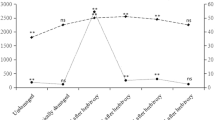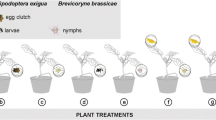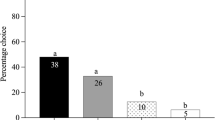Abstract
Herbivore feeding induces plants to emit volatiles that are detectable and reliable cues for foraging parasitoids, which allows them to perform oriented host searching. We investigated whether these plant volatiles play a role in avoiding parasitoid competition by discriminating parasitized from unparasitized hosts in flight. In a wind tunnel set-up, we used mechanically damaged plants treated with regurgitant containing elicitors to simulate and standardize herbivore feeding. The solitary parasitoid Cotesia rubecula discriminated among volatile blends from Brussels sprouts plants treated with regurgitant of unparasitized Pieris rapae or P. brassicae caterpillars over blends emitted by plants treated with regurgitant of parasitized caterpillars. The gregarious Cotesia glomerata discriminated between volatiles induced by regurgitant from parasitized and unparasitized caterpillars of its major host species, P. brassicae. Gas chromatography-mass spectrometry analysis of headspace odors revealed that cabbage plants treated with regurgitant of parasitized P. brassicae caterpillars emitted lower amounts of volatiles than plants treated with unparasitized caterpillars. We demonstrate (1) that parasitoids can detect, in flight, whether their hosts contain competitors, and (2) that plants reduce the production of specific herbivore-induced volatiles after a successful recruitment of their bodyguards. As the induced volatiles bear biosynthetic and ecological costs to plants, downregulation of their production has adaptive value. These findings add a new level of intricacy to plant–parasitoid interactions.



Similar content being viewed by others
References
R. P. Adams (2001) Identification of Essential Oil Components by Gas Chromatography/Mass Spectroscopy Allured Publishing Corporation Carol Stream
N. G. Agelopoulos M. A. Keller (1994) ArticleTitlePlant–natural enemy association in the tritrophic system, Cotesia rubecula–Pieris rapae–Brassicaceae (Cruciferae): II. Preference of C. rubecula for landing and searching J. Chem. Ecol. 20 1735–1748 Occurrence Handle10.1007/BF02059895
N. E. Beckage (1993) Games parasites play: The dynamic roles of proteins and peptides in the relationship between parasite and host N. E. Beckage S. N. Thompson B. A. Federici (Eds) Parasites and Pathogens of Insects Academic Press San Diego 25–57
A. Blaakmeer J. B. F. Geervliet J. J. A. Loon Particlevan M. A. Posthumus T. A. Beek Particlevan Æ. Groot Particlede (1994) ArticleTitleComparative headspace analysis of cabbage plants damaged by two species of Pieris caterpillars: consequences for in-flight host location by Cotesia parasitoids Entomol. Exp. Appl. 73 175–182
J. Brodeur J. B. F. Geervliet L. E. M. Vet (1996) ArticleTitleThe role of host species, age and defensive behaviour on ovipositional decisions in a solitary specialist and gregarious generalist parasitoid (Cotesia species) Entomol. Exp. Appl. 81 132 Occurrence Handle10.1007/BF00192137
M. Dicke (1999) ArticleTitleAre herbivore-induced plant volatiles reliable indicators of herbivore identity to foraging carnivorous arthropods? Entomol. Exp. Appl. 91 131–142 Occurrence Handle10.1023/A:1003608019062
M. Dicke M. W. Sabelis (1989) Does it pay plants to advertize for bodyguards? Towards a cost–benefit analysis of induced synomone production H. Lambers M. L. Cambridge H. Konings T. L. Pons (Eds) Causes and Consequences of Variation in Growth Rate and Productivity of Higher Plants SPB Publishing The Hague 341–358
M. Dicke J. J. A. Loon Particlevan (2000) ArticleTitleMultitrophic effects of herbivore-induced plant volatiles in an evolutionary context Entomol. Exp. Appl. 97 237–249 Occurrence Handle10.1023/A:1004111624780
M. Dicke L. E. M. Vet (1999) Plant–carnivore interactions: Evolutionary and ecological consequences for plant, herbivore and carnivore H. Olff V. K. Brown R. H. Drent (Eds) Herbivores: Between Plants and Predators Blackwell Science Oxford 483–520
J. B. F. Geervliet L. E. M. Vet M. Dicke (1994) ArticleTitleVolatiles from damaged plants as major cues in long-range host-searching by the specialist parasitoid Cotesia rubescula Entomol. Exp. Appl. 73 289–297
J. B. F. Geervliet A. I. Vreugdenhil M. Dicke L. E. M. Vet (1998) ArticleTitleLearning to discriminate between infochemicals from different plant–host complexes by the parasitoids Cotesia glomerata and C. rubecula Entomol. Exp. Appl. 86 241–252 Occurrence Handle10.1023/A:1003186706517
J. B. F. Geervliet M. S. W. Verdel S. Henk J. Schaub M. Dicke L. E. M. Vet (2000) ArticleTitleCoexistence and niche segregation by field populations of the parasitoids Cotesia glomerata and C. rubecula in the Netherlands: predicting field performance from laboratory data Oecologia 124 55–63 Occurrence Handle10.1007/s004420050024
H. C. J. Godfray (1994) Parasitoids—Behavioral and Evolutionary Ecology Princeton University Press Princeton
J. A. Harvey I. F. Harvey D. J. Thompson (1993) ArticleTitleThe effect of superparasitism on development of the solitary wasp parasitiod Venturia canescens (Hymenoptera: Ichneumonidae) Ecol. Entomol. 18 203–208
M. Hilker T. Meiners (2002) ArticleTitleInduction of plant responses towards oviposition and feeding of herbivorous arthropods: a comparison Entomol. Exp. Appl. 104 181–192 Occurrence Handle10.1023/A:1021232319226
M. E. Hoballah T. G. Kollner J. Degenhardt T. C. J. Turlings (2004) ArticleTitleCosts of induced volatile production in maize Oikos 105 168–180 Occurrence Handle10.1111/j.0030-1299.2004.12831.x
T. Ikawa Y. Suzuki (1982) ArticleTitleOvipositional experience of the gregarious parasitoid, Apanteles glomeratus (Hymenoptera: Braconidae), influencing her discrimination of the host larvae, Pieris rapae crucivora Appl. Entomol. Zool. 17 119–126
J. E. Laing J. E. Corrigan (1987) ArticleTitleIntrinsic competition between the gregarious parasite, Cotesia glomeratus and the solitary parasite, Cotesia rubecula (Hymenoptera: Braconidae) for their host, Artogeia rapae (Lepidoptera: Pieridae) Entomophaga 32 493–501
A. D. Masurier ParticleLe (1990) ArticleTitleHost discrimination by Cotesia (=Apanteles) glomerata parasitising Pieris rapae Entomol. Exp. Appl. 54 65–72 Occurrence Handle10.1007/BF00353988
L. Mattiacci M. Dicke M. A. Posthumus (1994) ArticleTitleInduction of parasitoid attracting synomone in Brussels sprouts plants by feeding of Pieris brassicae larvae: Role of mechanical damage and herbivore elicitor J. Chem. Ecol. 20 2229–2247 Occurrence Handle10.1007/BF02033199
L. Mattiacci M. Dicke M. A. Posthumus (1995) ArticleTitleβ-Glucosidase: An elicitor of the herbivore-induced plant odor that attracts host-searching parasitic wasps Proc. Natl. Acad. Sci. USA 92 2036–2040 Occurrence Handle11607516
L. Mattiacci S. Rudelli B. Ambühl Rocca S. Genini S. Dorn (2001) ArticleTitleSystemically-induced response of cabbage plants against a specialist herbivore, Pieris brassicae Chemoecology 11 167–173
C. R. Nufio D. R. Papaj (2001) ArticleTitleHost marking behavior in phytophagous insects and parasitoids Entomol. Exp. Appl. 99 273–293 Occurrence Handle10.1023/A:1019204817341
P. W. Paré J. H. Tumlinson (1997) ArticleTitleInduced synthesis of plant volatiles Nature 385 30–31 Occurrence Handle10.1038/385030a0
R. P. J. Potting H. M. Snellen L. E. M. Vet (1997) ArticleTitleFitness consequences of superparasitism and mechanism of host discrimination in the stemborer parasitoid, Cotesia flavipes Entomol. Exp. Appl. 82 341–348 Occurrence Handle10.1023/A:1002960625981
J. Ruther (2000) ArticleTitleRetention index database for identification of general green leaf volatiles in plants by coupled capillary gas chromatography-mass spectrometry J. Chromatogr. A 890 313–319 Occurrence Handle10.1016/S0021-9673(00)00618-X Occurrence Handle11009035
G. Salt (1961) ArticleTitleCompetition among insect parasitoids Symp. Soc. Exp. Biol. 15 96–119
E. A. Schmelz H. T. Alborn J. H. Tumlinson (2001) ArticleTitleThe influence of intact-plant and excised-leaf bioassay designs of volicitin- and jasmonic acid-induced sesquiterpene volatile release in Zea mays Planta 214 171–179 Occurrence Handle11800380
W. Sheehan F. L. Wäckers W. J. Lewis (1993) ArticleTitleDiscrimination of previously searched, host-free sites by Micoplitis croceipes (Hymenoptera: Braconidae) J. Insect Behav. 6 323–331 Occurrence Handle10.1007/BF01048113
K. Shiojiri J. Takabayashi S. Yano A. Takafuji (2000) ArticleTitleHerbivore-species-specific interactions between crucifer plants and parasitic wasps (Hymenoptera: Braconidae) that are mediated by infochemicals present in areas damaged by herbivores Appl. Entomol. Zool. 35 519–524 Occurrence Handle10.1303/aez.2000.519
K. Shiojiri J. Takabayashi S. Yano A. Takafuji (2001) ArticleTitleInfochemically mediated tritrophic interaction webs on cabbage plants Popul. Ecol. 43 23–29
S. Siegel (1956) Nonparametric Statistics for the Behavioral Sciences McGraw-Hill Kogakusha Tokyo
H. M. Smid J. J. A. Loon Particlevan M. A. Posthumus L. E. M. Vet (2002) ArticleTitleGC-EAG-analysis of volatiles from Brussels sprouts plants damaged by two species of Pieris caterpillars: olfactory respective range of a specialist and generalist parasitoid wasp species Chemoecology 12 169–176
R. Souissi J.-P. Nenon B. Rü ParticleLe (1998) ArticleTitleOlfactory responses of parasitoid Apoanagyrus lopezi to odor of plants, mealybugs, and plant–mealybug complexes J. Chem. Ecol. 24 37–48 Occurrence Handle10.1023/A:1022332711331
J. L. M. Steidle J. J. A. Loon Particlevan (2003) ArticleTitleDietary specialization and infochemical use in carnivorous arthropods: testing a concept Entomol. Exp. Appl. 108 133–148 Occurrence Handle10.1046/j.1570-7458.2003.00080.x
J. Takabayashi M. Dicke (1996) ArticleTitlePlant–carnivore mutualism through herbivore-induced carnivore attractants Trends Plant Sci. 1 109–113 Occurrence Handle10.1016/S1360-1385(96)90004-7
K. Takasu Y. Hirose (1988) ArticleTitleHost discrimination in the parasitoid Ooencyrtus nezarae: The role the egg stalk as an external marker Entomol. Exp. Appl. 47 47–48 Occurrence Handle10.1007/BF00186714
T. C. J. Turlings J. H. Loughrin P. J. McCall U. S. R. Röse W. J. Lewis J. H. Tumlinson (1995) ArticleTitleHow caterpillar-damaged plants protect themselves by attracting parasitic wasps Proc. Natl. Acad. Sci. USA 92 4169–4174 Occurrence Handle7753779
T. C. J. Turlings S. Gouinguené T. Degen M. E. Fritzsche Hoballah (2002) The chemical ecology of plant–caterpillar–parasitoid interactions T. Tscharntke B. A. Hawkins (Eds) Multitrophic Level Interactions Cambridge University Press Cambridge 148–173
J. J. M. Alphen Particlevan M. E. Visser (1990) ArticleTitleSuperparasitism as an adaptive strategy for insect parasitoids Annu. Rev. Entomol. 35 59–79 Occurrence Handle10.1146/annurev.en.35.010190.000423 Occurrence Handle2405774
J. Baaren Particlevan J.-P. Nenon (1996) ArticleTitleHost location and discrimination mediated through olfactory stimuli in two species of Encyrtidae Entomol. Exp. Appl. 81 61–69 Occurrence Handle10.1007/BF00187839
W. A. Giessen Particlevan W. J. Lewis L. E. M. Vet F. L. Wäckers (1993) ArticleTitleThe influence of host site experience on subsequent flight behavior in Microplitis croceipes (Cresson) (Hymenoptera: Braconidae) Biol. Control 3 75–79 Occurrence Handle10.1006/bcon.1993.1012
J. C. Lenteren Particlevan (1976) ArticleTitleThe development of host discrimination and the prevention of superparasitism in the parasite Pseudeucoila bochei (Hym.: Cynipidae) Neth. J. Zool. 26 1–83
J. C. Lenteren Particlevan (1981) Host discrimination by parasitoids D. A. Nordlund R. L. Jones W. J. Lewis (Eds) Semiochemicals—Their Role in Pest Control Wiley New York 153–179
J. J. A. Loon Particlevan J. G. Boer Particlede M. Dicke (2000) ArticleTitleParasitoid–plant mutualism: parasitoid attack of herbivore increases plant reproduction Entomol. Exp. Appl. 97 219–227 Occurrence Handle10.1023/A:1004032225239
L. E. M. Vet M. Dicke (1992) ArticleTitleEcology of infochemical use by natural enemies in a tritrophic context Annu. Rev. Entomol. 37 141–172 Occurrence Handle10.1146/annurev.en.37.010192.001041
S. B. Vinson (1985) The behavior of parasitoids G. A. Kerkut L. I. Gilbert (Eds) Comprehensive Insect Physiology, Biochemistry and Pharmacology Pergamon Press New York 417–469
U. Wittstock N. Agerbirk E. J. Stauber C. E. Olsen M. Hippler T. Mitchell-Olds J. Gershenzon H. Vogel (2004) ArticleTitleSuccessful herbivore attack due to metabolic diversion of a plant chemical defense Proc. Natl. Acad. Sci. USA 101 4859–4864 Occurrence Handle10.1073/pnas.0308007101 Occurrence Handle15051878
Acknowledgments
The authors thank Joachim Ruther, Joop van Lenteren, and Monika Hilker for advice and comments on an earlier version of this manuscript; Leo Koopman, Frans van Aggelen, and André Gidding for culturing the insects. Funding by the Bresillac Foundation is gratefully acknowledged. All experiments complied with the current laws of The Netherlands.
Author information
Authors and Affiliations
Corresponding author
Rights and permissions
About this article
Cite this article
Fatouros, N.E., van Loon, J.J.A., Hordijk, K.A. et al. Herbivore-Induced Plant Volatiles Mediate In-Flight Host Discrimination by Parasitoids. J Chem Ecol 31, 2033–2047 (2005). https://doi.org/10.1007/s10886-005-6076-5
Received:
Revised:
Accepted:
Published:
Issue Date:
DOI: https://doi.org/10.1007/s10886-005-6076-5




